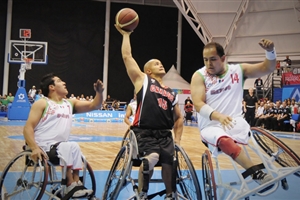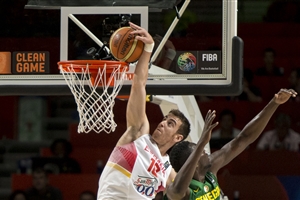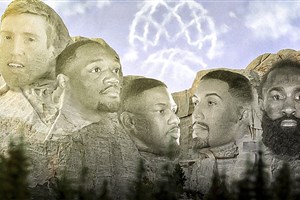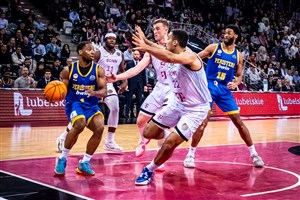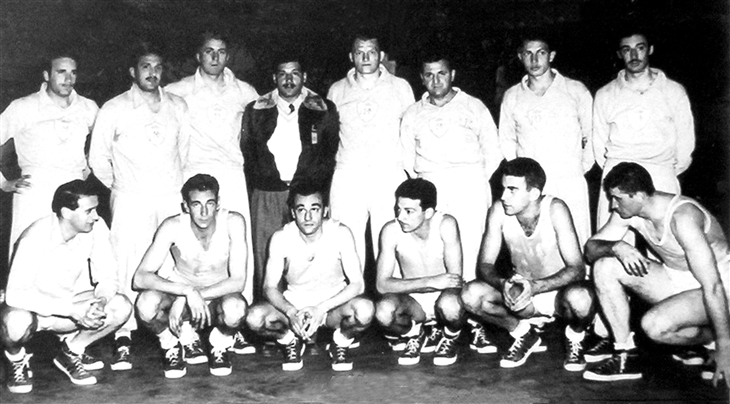
Uruguay then and now
SAN JUAN (William Rosario's Somewhere in the Americas) - This is a special week for basketball in the Americas. The Uruguayan Basketball Federation (FUBB) is celebrating its 100th birthday. It is a historic date for what is sure to be one of the if not the oldest basketball national federation ever.
In the Americas it is the oldest for sure; the Chilean Basketball Federation (FEBACHILE) was founded in 1924, the Peruvian Basketball Federation (FDPB) in 1926, the Argentinean Basketball Confederation (CABB) and the Puerto Rican Federation (FBPUR) in 1929, the Brazilian Basketball Confederation (CBB) in 1933 and the Venezuelan Basketball Federation (FVB) in 1935. Even the Canadian Basketball Federation was founded in 1923.
FUBB has always been a presence in continental basketball. They have had outstanding and legendary figures in the political, referees, coaches and players aspects of the game.
"Both Alberto Rosello and Federico Slinger are two of the most important men in the history of international basketball", said Jenaro “Tuto” Marchand, Secretary General Emeritus of FIBA Americas, when I asked about Uruguay’s importance in the sport.
"Rosello was president of the federation for 15 years, while Slinger was there for 16. You know how difficult it is to be head of a federation for that long in a high profile basketball country? It is practically impossible, but they were giants. Slinger was one of my biggest mentors. Slinger was FIBA Americas president and FIBA Central Board member. If he was alive today, he would be one of the most important voices in FIBA still", added Tuto.
Then there was Mario Hopenhaym. Another giant. An Uruguayan referee that worked the basketball court from 1963 to 1984 with a curriculum that includes the 1964 and 1968 Olympic Games, the 1967 World Championship and the 1971 and 1975 World Women’s Championship. Then, he was a Commissioner in the 1992, 1996, 2000 and 2004 Olympic Games. After quite the career, Hopenhaym was enshrined in the FIBA Hall of Fame in 2007.
Their men national team has two bronze medals in the 1952 Helsinki and 1956 Melbourne Olympic Games and 12 South American Championships that date from 1930 to 1997 with great players proudly wearing the “celeste” jersey for the country.
From Leandro Gómez Harley, captain of the 1930 South American Champion to Leandro Garcia Morales, Uruguay has had luminaries like Adesio Lombardo, Oscar Moglia, Carlos Peinado, Horacio “Tato” Lopez, Wilfredo Ruiz, Luis Pierri, Marcelo Capalbo, Nicolas Mazzarino, Martin Osimani, Esteban Batista and the now ACB League standout Jayson Granger.
To be honest with the current state of their team is to say they are in a transitional period. The Batista, Garcia Morales, Osimani and Mazzarino generation is now in the final stage of their run as national team members. They have all been international fixtures but as a unit have not been able to mount a great gold medal tournament.
Now, Uruguay waits for Granger (who has not played for the team since 2012) and hopes for the solidification of Bruno Fitipaldo at the point along with the maturity and development of young players like Luciano Parodi and Octavio Medina. But they lack big men in their national team program. There’s not an Esteban Batista in the works and it looks like that will hurt their chances moving forward.
What helps those chances though is the new 2017 FIBA competition system. Uruguay will be one of the countries that most benefits from the home and away games. For the country to be able to see their national team in competitive matches will be important and key for the kids and future generations coming up in their club structure. National team presence always helps. That Batista generation grew up in the Slinger-era, when the country used to organize big international championships. It’s no coincidence those kids grew up to love the game seeing great basketball being played right at home.
Also, and more immediate, it is pretty hard to beat Uruguay at home. Those fans can be crazy and they will for sure be a factor in close games. Add that to the fact that with 32 teams in the 2019 FIBA Basketball World Cup, the Americas will have more qualifying spots, which naturally increases their chances. They will be in a transitional period in the right moment in history where continuity will be a possibility with FIBA’s inclusive plan.
The media will be there too. They’ve always been there. And if it’s true that the media don’t win any games, I think they deserve special praise. Basketball is still relevant in Uruguay 100 years later.
I’ve said it before in this column, but going to Uruguay to watch a basketball game has a throwback feeling to it. Their geographical specificity allows it to be so.
Their league is played with 13 to 14 teams that are within blocks of each other with an intensity and rivalry that you seldom see in national basketball around the world. And the media lives and breathes it.
It is normal to go to a national league game and see many live radio broadcast that go on for hours with pre game, post game show and day recap.
With people listening. “Our show goes live at midday in a sports radio station. We are the only basketball show in futbol inundated programming, but when the ratings come we are always number one.”, told me an Uruguayan colleague.
To all of them, the legends, current greats, future stars, media members and fans…thank you, you make Uruguay a unique basketball country in the history of the sport. We, from the outside looking in, celebrate you.
William Rosario
FIBA
FIBA's columnists write on a wide range of topics relating to basketball that are of interest to them. The opinions they express are their own and in no way reflect those of FIBA.
FIBA takes no responsibility and gives no guarantees, warranties or representations, implied or otherwise, for the content or accuracy of the content and opinion expressed in the above article.


